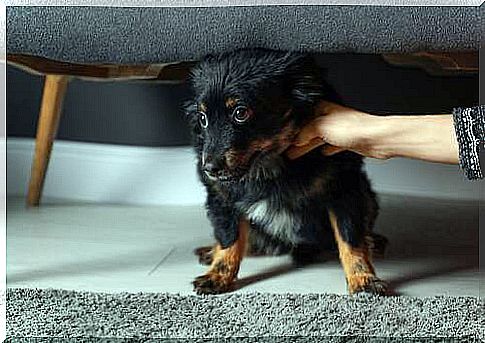Health And Mental Illness In Dogs: How To Cure Them

Within canine psychology, there is the area of health and mental illness in dogs. In fact, like any other animal with a highly developed brain that possesses the neurotransmitters responsible for emotions, dogs can also suffer from mental illness.
These pathologies involving the psychology of the dog are very varied and, as happens in humans, not all dogs evolve in the same way. In addition, there are dogs who suffer more from their owner’s departure, others who are worse off being locked up or suffering from pathological fears and phobias.
In this article we will look at some examples of mental illness in dogs, along with their possible treatments. In any case, medical care should be taken under the supervision of a veterinarian. Let’s see together what are the main mental illnesses in dogs.
Separation anxiety in dogs
One of the main psychological disorders that dogs suffer from is separation anxiety from the owner. When the owner leaves the house and leaves the dog alone, he could engage in a series of negative behaviors that can lead to complaints from neighbors or the dog abandoning the dog by the owner:
- Eating inedible things.
- Out of control barking.
- Destruction of the furniture in the house.
- Pee and poop in the house.
These behaviors make bosses despair who, in most cases, do not know how to act. Often, in desperation, reactions can occur that worsen the state of the animal.

However, it is worth remembering that during episodes of anxiety, the dog is in a very high state of stress and is unable to handle frustration. The most common consequence is that you feel fear.
According to recent studies, animals handle emotions better if they feel they are in control. For example, in these cases the owner tries to hide from the dog that he is going out and, moreover, when he returns and the dog has done something that he should not have done, he does not greet him. All this worsens the dog’s anxiety picture.
To cure separation anxiety in dogs, we must first improve the pet’s self-control ability. This is achieved through the exercise of smell, i.e. tests in which the dog must use his nose to find a treat.
On the other hand, we have to train the dog to get used to our outings. For example, we can leave the house leaving a yellow scarf in sight. Once back, we’ll calmly say goodbye and remove the scarf. We have to do it every day for a long time. When we go away longer, we will leave a scarf of another color.
The most important thing is to always greet the dog on our return. If he is very anxious and we don’t even look at him, we will further increase his anxiety and frustration.
On the other hand, when we will be away from home longer, for example to work, we can prepare a game of smell to make him play a little and get mentally tired.
Stereotypes and deleterious behaviors
Stereotypes are a set of repetitive behaviors, carried out in sequence and with no apparent purpose. These behaviors are never observed in nature. They appear as a result of domestication and, most importantly, childbirth.

On the other hand, there are also deleterious behaviors, which are also obsessive behaviors. However, in them the animal mutilates itself and the risk of physical damage is greater.
These types of behavior only occur when the dog is confined for a certain period. In fact, it is typical in dogs that come from kennels. When stereotyped behaviors are observed, the mental health and well-being of the animal can be considered compromised.
The only way to address these behaviors is through environmental enrichment. Environmental enrichment consists in making the place where the animal lives resemble its natural habitat. Also, toys and food can be used to reduce boredom levels.
Health and mental illness in dogs: phobias
Among the mental illnesses in dogs, phobias are very strong anxiety disorders. They usually generate an irrational fear of social and non-social situations, which cause severe anxiety in dogs.
Dogs that usually exhibit this type of irrational fear are generally those that have not enjoyed proper social development during weaning. In addition, dogs that live locked up and isolated for most of their lives, such as breeding or hunting animals , also suffer from it.
The treatment for phobias can be conducted and addressed through specific drugs. However, it is necessary to consult a canine educator and a veterinarian, who can guide us towards the right therapy.








